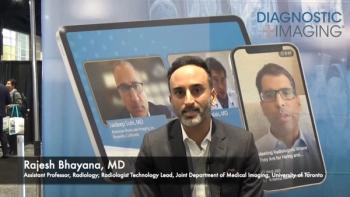
CT vendors vie for leadership with emerging technologies
An hour after the RSNA show floor opened, employees of Philips Medical Systems lifted the earth-toned drape that obscured the company’s answer to Toshiba’s flat-panel CT. The 256-slice system was as much a surprise as Toshiba’s 320-element system, as each company exceeded expectations in an industry marked this year by superlatives.
An hour after the RSNA show floor opened, employees of Philips Medical Systems lifted the earth-toned drape that obscured the company's answer to Toshiba's flat-panel CT. The 256-slice system was as much a surprise as Toshiba's 320-element system, as each company exceeded expectations in an industry marked this year by superlatives.
Nearby in the South Hall, GE Healthcare was promoting its HD (high-definition) CT as the means to see unprecedented detail with CT: soft tissue in the bowel, bladder, and prostate; liver vasculature and muscle stratification; brain aneurysms; and even the fine mesh that composes stents implanted to stabilize aneurysms. Across the Grand Concourse in the North Hall, Siemens Medical Solutions showed its Definition AS (Adaptive Scanning), whose 0.24-mm pixels and 300-msec rotations promised resolution that would vastly improve stroke assessment and cancer characterization.
All but the Toshiba system are works-in-progress, and their commercial release dates are shrouded by red tape. Aquilion One, the only one of the four new-breed CTs cleared by the FDA, is slated for release in summer 2008.
Siemens and GE hinted that their systems could be available some time in 2008. Philips predicted early 2009. None could talk price, since doing so would constitute marketing, a practice the FDA frowns on when discussing investigational devices.
In describing the power of the Brilliance iCT, however, John Steidley, Ph.D., vice president of global marketing CT for Philips, indicated that the company's new scanner would carry a hefty price tag.
"We have doubled a lot of things on this system, including the price roughly, so it is a very expensive system," Steidley said.
This end of the price spectrum is getting crowded. Toshiba is pricing its Aquilion One between $2.5 million and $2.8 million. Siemens is already there with its dual-beam CT, the Definition, which was released commercially last year.
The German company introduced another high-end system at the RSNA show, Definition AS. This single x-ray source product is built from many of the same components and base technologies as its dual-beam cousin (DI SCAN 11/27/07,
GE's HDCT is really more a platform than a product, at least for now. Company executives told DI SCAN that major components have been tested clinically at the Medical College of Wisconsin in Milwaukee, but a fully assembled model is still in the works. Its potential, like that of its competitors, is exceptional.
All four CT vendors have reengineered the imaging chains in their new breed of scanners. GE has swapped its decades-old detector material for one that is 98% composed of garnet. The new material responds 150 times faster to the light created by x-ray strikes on the detector and cuts afterglow to one-tenth of the previous time. It also substantially reduces signal noise.
"This cuts out a lot of the artifacts found in traditional CT imaging," said Dominic P. Smith, general manager of molecular imaging, CT marketing, and advanced applications for GE Healthcare. "Beam hardening goes away."
Philips is positioning its iBrilliance as the means for quickly generating high-quality whole-organ coverage. The new scanner rotates four times per second to complete an entire heart exam in two beats, according to the company. Data are generated using a wholly redesigned imaging chain, Essence.
The Essence detector built into the Brilliance iCT has 128 elements. The number of slices per element is doubled using a smart focal spot that moves in the z direction, creating 256 slices per rotation.
The protocols for getting the most out of Philips' new scanner will come from experience gained over the next year or so at 10 beta sites, where Brilliance iCT will be installed during the next four or five months, according to Steidley.
"We're going to take the time to ensure that when we deliver to customers, it is very simple and easy to use," he said.
Siemens, Philips, and GE each have minted their own versions of a CT shuttle technique that moves the patient back and forth beneath the detector to widen the area of coverage. This technique can support blood perfusion studies of organs such as the brain, heart, lungs, or liver. The vendors are framing their approaches as equivalent to or better than each other's, including Toshiba's.
Not since the commercial launch of 16-slice scanners six years ago have vendors shown this kind of competitive intensity. Feeding it is this year's down market for CT in the U.S., where reimbursement cuts have damped sales. The only hope for an upturn is the emergence of a new reason to buy high-end CTs.
This abstraction now characterizes the CT industry, as vendors focus on the sizzle to whet an appetite for the steak, hoping to make their products sound a little better - or at least as good - as that of their competitors. It is a sign that competition will heat up even more as vendors get closer to actually shipping their new products.
Newsletter
Stay at the forefront of radiology with the Diagnostic Imaging newsletter, delivering the latest news, clinical insights, and imaging advancements for today’s radiologists.




























